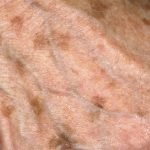 Small circumscribed changes in the color of skin that are neither raised (elevated) nor depressed.
Small circumscribed changes in the color of skin that are neither raised (elevated) nor depressed.
A completely flat circumscribed change in the color of skin that can only be appreciated by visual inspection and not by touch.
Discolored spot of skin that is neither elevated above nor depressed below the surrounding skin surface.
A discolored spot or patch on the skin that is not raised above the skin’s surface.
A small flat coloured spot on the skin.
Small blemish or discoloration that is not raised above the skin surface (e.g., freckle).
A spot, discoloration, or thickening of the skin that forms a distinct area from the surrounding normal surface.
Areas of small, flat or slightly raised skin discoloration which may occur in a wide range of conditions, such as many viral infections, e.g. measles, as well as conditions such as eczema (dermatitis), psoriasis, syphilis and. after burns. In children, the combination of high fever and a few macules is sometimes an early premonitory sign of meningococcal or pneumococcal septicaemia.
A flat spot on the skin whose color may be lighter or darker than the surrounding skin. Some common examples are freckles, petechiae, and vitiligo.
Flat spot or discoloration on the skin, such as a freckle or a red spot left after a pimple has healed.
A mark that is flush with the skin and is noticeable due to its distinct color or texture.
